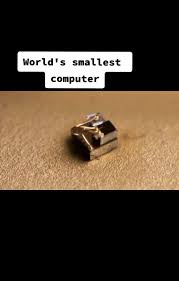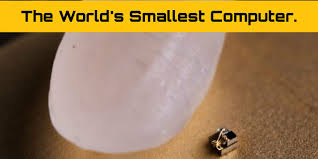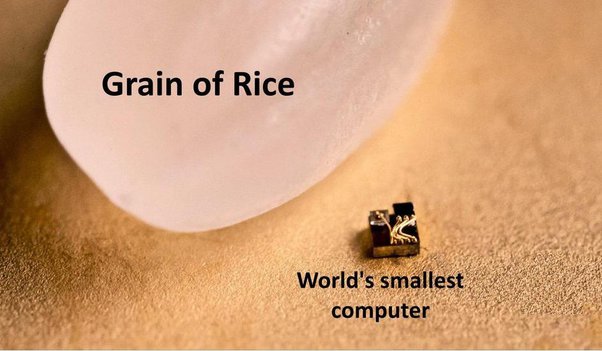Introduction
The relentless pursuit of miniaturization in technology has led to incredible feats, and the title of the world’s tiniest computer currently belongs to a mind-boggling creation by researchers at the University of Michigan. This remarkable device, unveiled in 2017, measures a mere 0.3 millimeters on a side, making it smaller than a single grain of rice! While the definition of a “computer” at such an impossibly small scale might be debatable, this microscopic marvel possesses the fundamental components that allow it to perform rudimentary computational tasks even after being world’s tiniest computer, smaller than a grain of rice.

Let’s delve deeper into the details of this technological wonder:
Size and Fabrication: A Microscopic Marvel
Imagine something smaller than a single speck of dust. That’s the realm we enter with the University of Michigan‘s world’s tiniest computer. Fabricated using a complex process known as nanolithography, the device is built on a thin film of silicon, the same material used in traditional computer chips. However, the process differs dramatically. Instead of etching circuits onto a flat surface, researchers create three-dimensional structures using a combination of light, chemicals, and specialized materials. This allows them to pack an incredible amount of functionality into a minuscule space.
Inner Workings: Essential Components at Microscopic Scale
Despite its size, the world’s tiniest computer boasts the essential components of a computing device:
1. Processing Unit: The “brain” of the computer is a micro-sized ring oscillator, a circuit that uses transistors to generate electrical oscillations. While not as powerful as the CPUs found in our laptops or smartphones, it allows the computer to perform basic logic operations and execute simple programs.
2. Memory: The device uses a small amount of non-volatile memory, similar to flash memory in traditional computers. This allows it to store a limited amount of data, even when power is off.
3. Input/Output: This tiny computer can interact with the outside world through radio waves. It can receive instructions and transmit data wirelessly, enabling communication with external devices.
4. Sensors: The current iteration of the device includes a simple temperature sensor, allowing it to detect and measure its surrounding environment.
Functionality: Stepping into the Realm of Microscopic Computing
Despite its limitations, this tiny computer can perform some remarkable tasks:
- Sensing Temperature: As mentioned earlier, the device can measure its surrounding temperature thanks to the integrated sensor. This basic function can be useful in applications where monitoring temperature fluctuations is crucial, especially in tight spaces.
- Wireless Communication: The ability to send and receive data wirelessly allows the computer to interact with external entities. This opens the door for potential applications where information needs to be transmitted from a tiny, implanted device.
- Simple Image Processing: In a 2019 study, researchers demonstrated that the device could be used for rudimentary image processing. It was able to distinguish between light and dark areas in a simple image, paving the way for potential future applications in areas like medical imaging.
The Future of Tiny Computers: Big Applications on a Microscopic Scale
The possibilities for these miniature marvels are vast and hold immense potential for revolutionizing various fields. One of the most exciting possibilities lies in biomedical applications. Researchers envision integrating these tiny computers into biological systems, allowing them to monitor and interact with cells and organs on an unprecedented level. This could lead to breakthroughs in areas like:
- Drug Delivery: By embedding these computers in drug delivery systems, scientists could monitor and control the release of medication at a cellular level, ensuring targeted and precise treatment.
- Neuroscience: Integrating such computers with neural systems could open doors to studying brain function and potentially treating neurological disorders with greater precision.
- Biosensing: These tiny devices could be used to monitor various biological parameters within the body in real-time, providing valuable insights into health and disease.
However, significant challenges remain in harnessing the full potential of these microscopic computers. Their limited processing power, memory capacity, and energy efficiency need significant improvements. Additionally, ensuring biocompatibility and developing safe and reliable methods for integrating them with living systems are crucial hurdles that need to be overcome.

Conclusion: A Stepping Stone in the Miniaturization Journey With the World’s Tiniest Computer
The development of the world’s tiniest computer represents a significant achievement in miniaturization technology. While its current capabilities are limited, it lays the groundwork for future advancements and opens doors to fascinating possibilities in various fields. As researchers overcome the various challenges, these tiny computers might pave the way for a future where microscopic devices revolutionize medicine, research, and potentially even daily interactions with technology. With continued research and development, this tiny computer might be just the first step in a giant leap towards a future where technology shrinks to unimaginable scales, reshaping the world as we know it.




